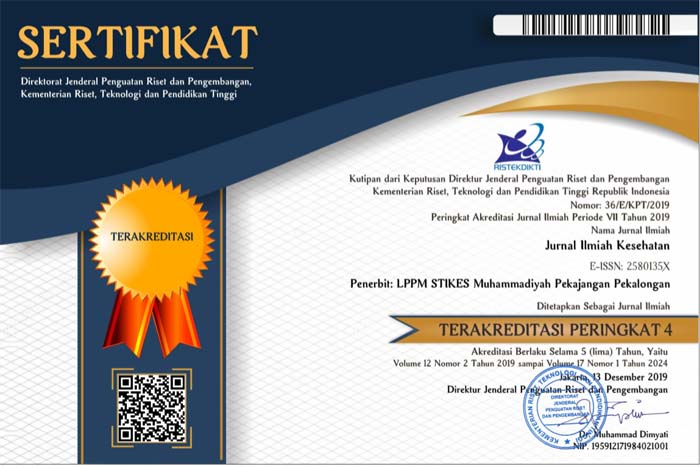Status Gizi pada Wanita Perimenopause yang Mengalami Keluhan Klimakterik
DOI:
https://doi.org/10.48144/jiks.v5i2.33Abstract
Abstrak : Perimenopause adalah fase peralihan antara pre menopause dan pasca menopause (usia 45-55 tahun) yang ditandai dengan munculnya keluhan klimakterik akibat turunnya fungsi indung telur dan dipengaruhi oleh faktor psikis, lingkungan, sosio-ekonomi termasuk di dalamnya status gizi. Konversi terbanyak androgen menjadi estrogen terjadi di jaringan adiposa, sehingga wanita gemuk memiliki sirkulasi estrogen lebih banyak dengan keluhan klimakterik yang lebih rendah dibanding wanita kurus. Tujuan penelitian ini adalah untuk mengetahui hubungan status gizi dengan terjadinya keluhan klimakterik pada wanita perimenopause di Desa Rengas Kecamatan kedungwuni kabupaten Pekalongan tahun 2012. Desain penelitian ini menggunakan metode deskriptif korelatif dengan pendekatan cross sectional. Sampel dalam penelitian ini adalah area probability sampling atau sample wilayah yang berjumlah 70 responden. Pengumpulan data secara door to door menggunakan alat ukur antoprometri dan kuesioner. Analisa hasil penelitian sebagian besar (61,1%) keluhan klimakterik berat dialami oleh wanita perimenopause dengan status gizi kurus dan sebagian besar (60%) keluhan klimakterik ringan dialami oleh wanita perimenopause dengan status gizi normal. Saran bagi tenaga kesehatan hendaknya dapat membantu ibu untuk memperoleh informasi mengenai perimenopause serta gejala-gejala yang terjadi saat perimenopause.
Kata kunci: Status Gizi, Keluhan Klimakterik, Perimenopause.
Â
Nutritional Status in Premenopausal Women Experiencing the Climacteric Complaints
Abstract. Perimenopause is the transition phase between premenopausal and postmenopausal (age 45-55 years) is characterized by the appearance of climacteric complaints as a result of the decline in ovarian function and is influenced by psychological factors, environmental, socio-economic including nutritional status. Highest conversion of androgens to estrogens occur in adipose tissue, so that obese women have more estrogen circulating with climacteric complaints were lower than thin women. The purpose of this study was to determine the relationship of nutritional status and the occurrence of climacteric complaints in perimenopausal women in the village RENGAS Kedungwuni District of Pekalongan district in 2012. The design of this study using correlative descriptive method with cross sectional approach. The sample in this study is an area probability sampling or sample the region totaling 70 respondents. Data collection door to door using a measuring instrument antoprometri and questionnaires. Analysis of the results of the study the majority (61.1%) severe climacteric complaints experienced by perimenopausal women with thin nutritional status and most (60%) mild climacteric complaints experienced by perimenopausal women with a normal nutritional status. Advice for health workers should help the mother to obtain information about perimenopause as well as the symptoms that occur when perimenopause.
Keywords: Nutritional status, climacteric complaints, Perimenopause.











